Top Tier CPU Air Coolers Q3 2015: 9-Way Roundup Review
by E. Fylladitakis on July 6, 2015 8:00 AM ESTThe Thermalright Macho Zero
Being one of the oldest and most reputable manufacturers of advanced cooling solutions, Thermalright does not really need much of an introduction in such a review. Ever since 2001, Thermalright is totally focused on designing and producing cooling solutions for PC components, with the mere exception of a heatsink for the XBOX 360. The company greatly surprised us with their submission for this review. With this being a roundup review of top performance coolers, almost anyone would expect to see the Silverarrow or HR-22 (or a Copper TRUE? - Ian). However, Thermalright submitted the Macho Zero - a cooler optimized for passive performance and low airflow environments!
Thermalright supplies the Macho Zero in a very plain black cardboard box, with just a schematic of the cooler printed on it. Inside the box, the cooler is very well protected inside thick polyethylene foam pieces. Note that the Macho Zero is not supplied with a fan. For the means of this review, Thermalright supplied us with a single TY-147A 140 mm fan.
The bundle of the Macho Zero is the most thorough of this review. Thermalright nickel-plated the screws and retention plates necessary for the mounting of the cooler, supplies a tube of quality "Chill Factor III" thermal paste, anti-vibration rubber pads and wire clips for one cooling fan, provides a full size magnetic 150 mm shank Philips PH2 screwdriver and even gloves for the installation of the cooler.
Although the Macho Zero is primarily optimized for semi-passive cooling, meaning that it has been designed to make use of the airflow generated by the fans of the case, it is possible to install any 120 mm or 140 mm fan on it. For the means of this review, the cooler had to be in active configuration, therefore Thermalright supplied us with a TY147A 140 mm fan. The white bladed fan with the rounded frame is a model designed for efficient airflow and low-noise operation. This means that the fan is optimized for low impedance applications, such as to replace case fans. Normally, that would make it mediocre for a very dense cooler, but that is not the case with the Macho Zero. It has a maximum rotational speed of 1300 RPM and an "enhanced hyper-flow bearing", for which we could not find specific information about, but it definitely is a form of fluid sleeve-type mechanism.
The Macho Zero is an imposing, large single tower CPU cooler. Its fins are almost perfectly rectangular, with many openings across their great surface. There are not too many fins though, as the spacing between them is very large in comparison to other coolers. This has been done to optimize this cooler for very low airflow environments and greatly lowers its airflow impedance. For aesthetic purposes, Thermalright painted the top fin black, yet it does not cover the heatpipe endings. There is a fairly large hole near the rear side of the fins, meant for the screwdriver to go through for the mounting of the cooler. Note that for the mounting of this cooler, the front fan (if present) needs to be removed as well.
Typically, the Macho Zero is designed for use without a fan. An optional fan can be used of course, but remember that high airflow / low pressure options are likely to be far more effective than high pressure fans. The provided wire clips are an excellent fit for 140 mm fans with rounded frames, yet their configuration does not allow the adjustment of the fan's height. It would be wise to check the mechanical specifications of the cooler and make sure that the installation of a fan does not restrict the installation of RAM modules in slots that need to be used.
The base of the Macho Zero is of notable importance. The copper base is rectangular and wide to provide full contact with Haswell-E processors, with six 6 mm heatpipes going through it. The heatpipes are split into two groups, with heatpipes 1-3-5 expanding near the rear of the heatsink and heatpipes 2-4-6 near the front. This approach allows the localized generation of a heavy thermal load to be split across the surface of the fins. Everything is nickel plated and the contact surface is treated to a perfect mirror finish.


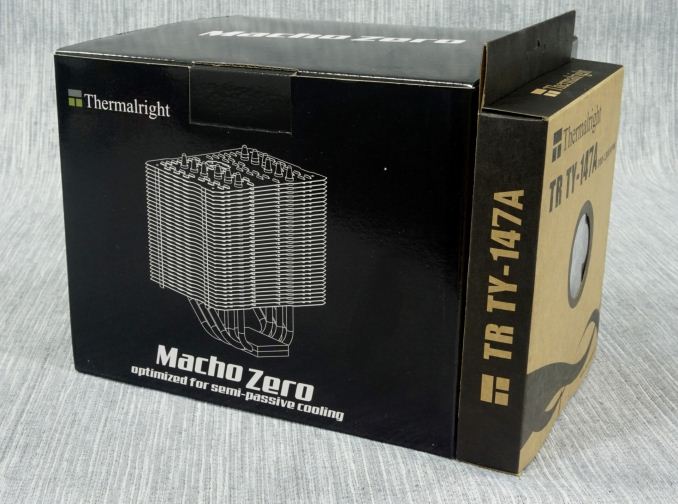
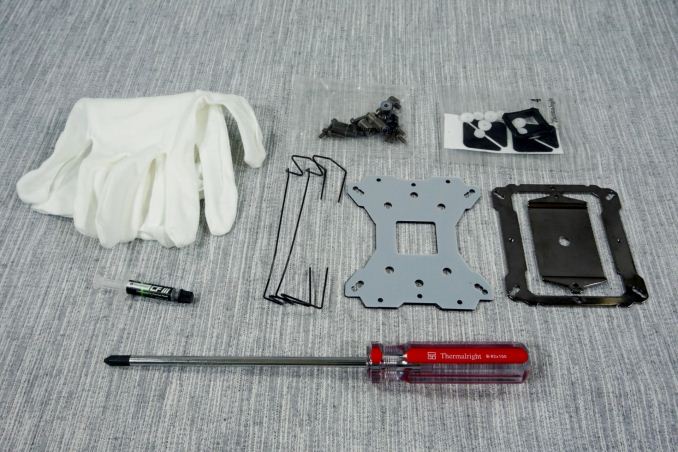
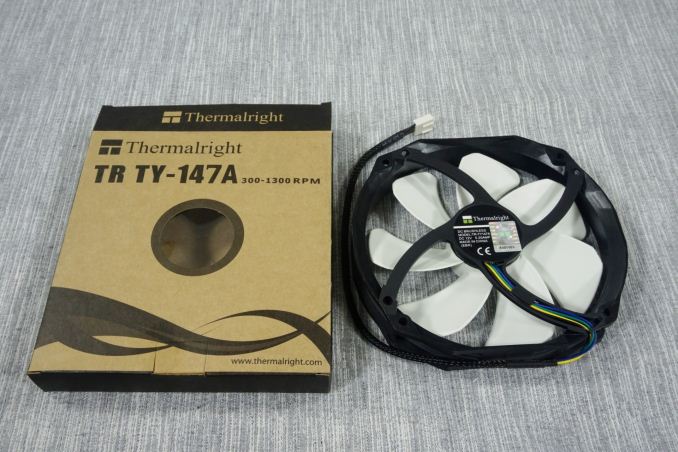
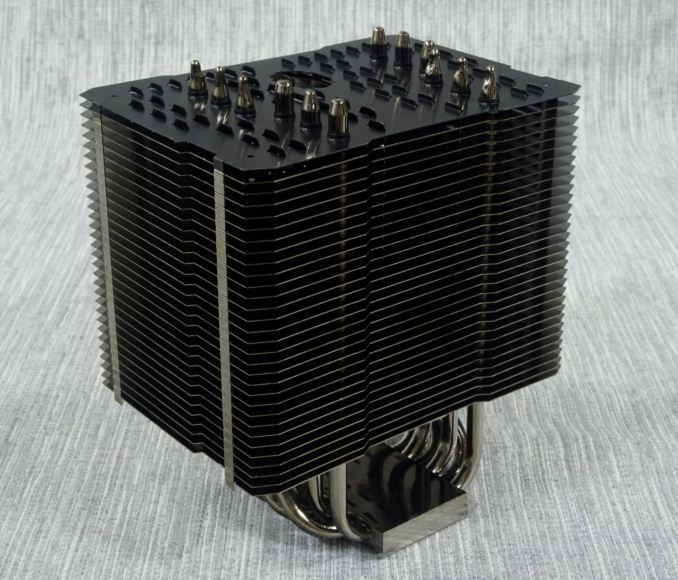
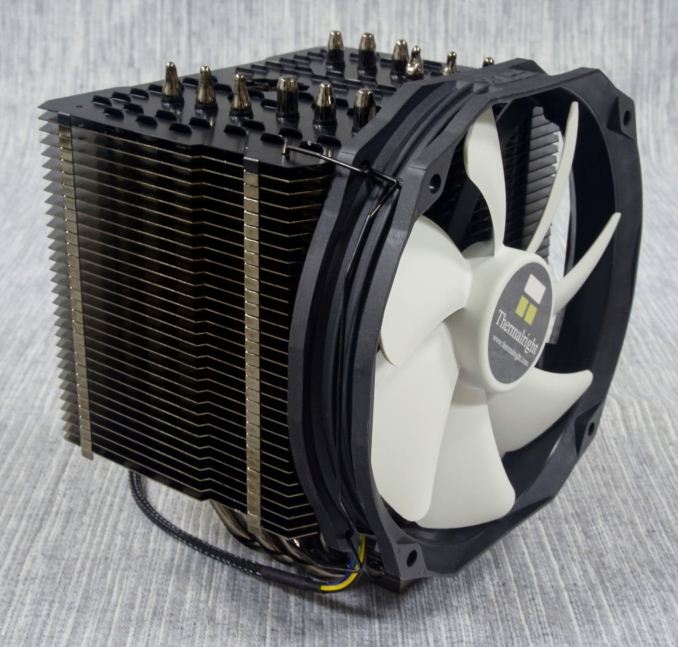
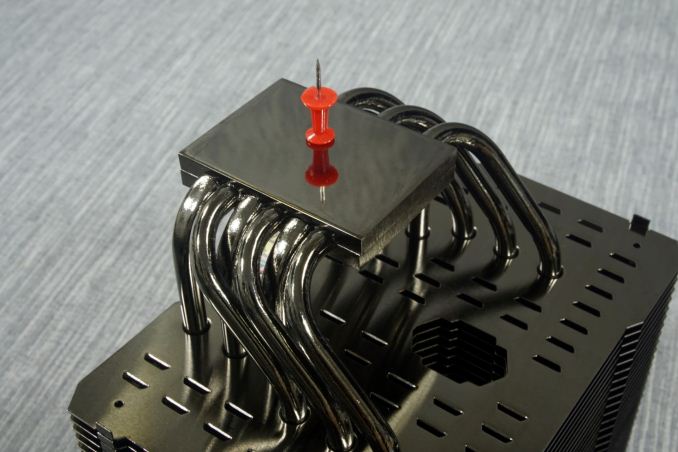








135 Comments
View All Comments
'nar - Tuesday, July 7, 2015 - link
I know right? I was so looking forward to a W/C vs A/C comparison after an intro like that.Margalus - Monday, July 6, 2015 - link
why didn't you test these all with the same fan? Then we could see how the cooler performed independent of the included fans? Like the Thermalright, it comes with no fan, apparently you got a super quiet slow fan and put on there, but that isn't fair to Thermalright saying they are hotter, when it could be because it doesn't have the amount of air moving over the fins as others.Beany2013 - Wednesday, July 8, 2015 - link
Thermalright provided the fan, so they can't grumble at the results.trandoanhung1991 - Monday, July 6, 2015 - link
When you talk about ultimate cooling, you should've at least tested the True Spirit 140 Power Edition with a TY-143 fan, or the Silver Arrow SB-E Extreme. Those are the most interesting products from Thermalright, not the Macho Zero.Maybe as an addendum at some point? I'm very interested to see how the Silver Arrow and the 140 PE fare against the D15.
Impulses - Tuesday, July 7, 2015 - link
Apparently the Macho is what TR themselves chose to send AT, if the intro is accurate... Big /facepalm on their part. They probably have some of the best value coolers in the TRUE Spirits (I have the original Cogage version myself), and the Silver Arrow might've ranked up there with the Noctua and Phantek. The article did make me pretty curious about the latter tho, call me vain but the color choices are cool.Calculatron - Monday, July 6, 2015 - link
Thanks for doing a heatsink round-up. They are refreshing to see these days.It is a shame that Thermalright did not send in its top-tier performer. Then again, the Macho Zero is nothing to sneeze at. ~40C over ambient for a 340 watt load is still a good result. (Perhaps, instead, they could have thrown the TY143 performance fan instead? Har!)
siberus - Tuesday, July 7, 2015 - link
I actually wish they would have sent 2 of the current fans so we could see if push/pull could push it up a performance bracket.rrohbeck - Tuesday, July 7, 2015 - link
I'd like to see the measurements all with the same fan(s) - whatever is considered "the best" fan. That would give an indication of how much you could get out of the cooler with aftermarket fans.'nar - Tuesday, July 7, 2015 - link
I wish there was more review cross-over with water coolers, these two camps seem to be at odds with each other. They never seem to be compared effectively to each other, so it is difficult for consumers to determine the "best" cooler for themselves. With Noctua getting up to $93, there are water coolers out there for less. I bought my Noctua NH-D14 for $75 and thought that was high for a HSF.I strictly used air coolers until I got an AMD APU, among them are several Noctua models. It was apparent to me that this CPU, after a bit of easy O/C, got hot much too fast for an air cooler to absorb. It would crash after just 4 seconds of starting Tomb Raider and the cooling fins were still ambient temperature. I tried three coolers including the Noctua NH-D14. Fan speed did not matter as the rapid increase in temperature exceeded the heatsinks' ability to draw the heat off the CPU itself. I would guess that it take anywhere from 30 seconds to a minute for the heat to actually get to the fins, so if your heat sink cannot "sink" the heat all by itself, no fan, for a full minute, then it has inadequate heat transfer and no fan will fix that.
I installed a Corsair H100i and that works very well. I had previously thought that any cooler with less surface area would have less cooling performance, but I have found that if you cannot transfer the heat to the fins, they make no difference. I think a Corsair H60 would have been fine now. I heard that water coolers were "better" and more efficient, but nobody ever explains WHY.
From this experience at least, it appears that water coolers have better heat transfer performance. Fan speeds and fins are secondary to that, as they do not matter until the heat gets to them. If they get hot, then low speed fans can easily remove that heat as higher temperature differentials generally allow for greater heat transfer. If you run high-power and high-heat for a long time, then higher fan speeds help.
How quickly can your test bench ramp up in power? Was that tested? Was that considered? CPU's can hit maximum power in nanoseconds, and crash in milliseconds. Only the base of the HSF would see anything from that event. I think this test is more academic, and not very relevant in the real-world with actual CPU's. It only tests for maximum heat generation over time, like when running benchmarks, not the dynamic nature in which CPU's operate for most useful loads. But then, that's just my perspective.
Pissedoffyouth - Tuesday, July 7, 2015 - link
I agree with you. I think the heat transfer through heatpipes takes quite some time to get to the fins